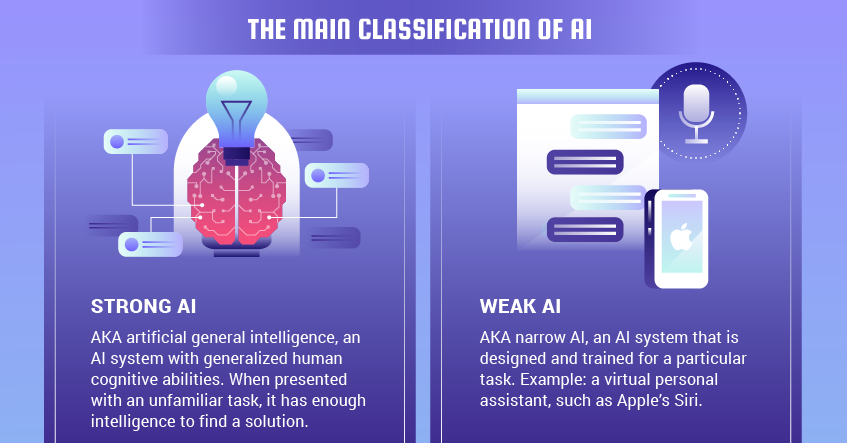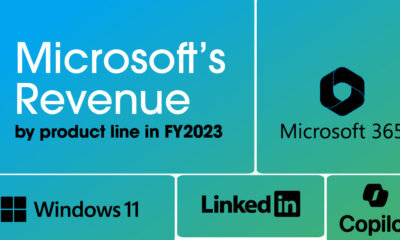Technology
Visualizing the AI Revolution in One Infographic
Science fiction didn’t do a great job in preparing us for our first real encounters with AI.
Most people probably still envision AI in the form of a sentient robot that can talk, move around, and experience feelings – something like WALL-E or C-3PO from the movies.
Although that still may be the dream, it turns out that the current iteration of AI is actually quite different. With modern AI, all the “thinking” gets done in the cloud, and the algorithms aren’t tied to the identity of a physical machine like we would have expected from the big screen.
The modern iteration of AI works silently in the background without a face, and it’s starting to impact everything it touches. It’s also set to transform our economy at warp speed.
Putting Modern AI Into Context
Today’s infographic from TechJury helps you understand the context around this emerging force.
Entitled “The AI Revolution”, it covers the brief history of AI, the industries that will be affected, as well as some key AI statistics that are likely to catch your eye.

Note: The infographic references a chatbot named Eugene Goostman that allegedly passed the Turing Test in 2014. Please note that this is a very contentious claim: while it did fool 33% of judges that it was a human, many experts object to the claim for a wide variety of reasons.
Artificial intelligence is here and it’s transforming our economy.
One estimate by PwC puts the global impact of AI at $15.7 trillion by 2030, while Accenture says that AI could double the rate of economic growth in developed countries by 2035.
If either of these two predictions come true, it will mean big change for almost every industry.
The AI Revolution: By the Numbers
What does it look like when AI takes the world be storm?
The following stats will give you an indication on the potential impact of the AI revolution, and how it’s already shaping the future of business thinking:
- The number of AI startups has increased 14x since the year 2000
- The amount of investment in AI startups has increased 6x since 2000
- 15% of enterprises in 2018 already use AI, but 31% more will come on board in the next 12 months
- 72% of executives see AI as being the most significant future business advantage
- 84% of global businesses see AI as providing a competitive advantage
- 41% of consumers believe AI will improve their lives in some way
- By 2020, businesses using AI to drive consumer insights will see $1.2 trillion more per year than their less-informed competitors
So while the AI revolution is not led by the identifiable face of a friendly (or antagonistic) robot in a physical form, experts agree that impact of AI on business will be profound.
See how the prevailing myths about AI in the workplace have been debunked, to learn even more on the subject.
Technology
All of the Grants Given by the U.S. CHIPS Act
Intel, TSMC, and more have received billions in subsidies from the U.S. CHIPS Act in 2024.

All of the Grants Given by the U.S. CHIPS Act
This was originally posted on our Voronoi app. Download the app for free on iOS or Android and discover incredible data-driven charts from a variety of trusted sources.
This visualization shows which companies are receiving grants from the U.S. CHIPS Act, as of April 25, 2024. The CHIPS Act is a federal statute signed into law by President Joe Biden that authorizes $280 billion in new funding to boost domestic research and manufacturing of semiconductors.
The grant amounts visualized in this graphic are intended to accelerate the production of semiconductor fabrication plants (fabs) across the United States.
Data and Company Highlights
The figures we used to create this graphic were collected from a variety of public news sources. The Semiconductor Industry Association (SIA) also maintains a tracker for CHIPS Act recipients, though at the time of writing it does not have the latest details for Micron.
| Company | Federal Grant Amount | Anticipated Investment From Company |
|---|---|---|
| 🇺🇸 Intel | $8,500,000,000 | $100,000,000,000 |
| 🇹🇼 TSMC | $6,600,000,000 | $65,000,000,000 |
| 🇰🇷 Samsung | $6,400,000,000 | $45,000,000,000 |
| 🇺🇸 Micron | $6,100,000,000 | $50,000,000,000 |
| 🇺🇸 GlobalFoundries | $1,500,000,000 | $12,000,000,000 |
| 🇺🇸 Microchip | $162,000,000 | N/A |
| 🇬🇧 BAE Systems | $35,000,000 | N/A |
BAE Systems was not included in the graphic due to size limitations
Intel’s Massive Plans
Intel is receiving the largest share of the pie, with $8.5 billion in grants (plus an additional $11 billion in government loans). This grant accounts for 22% of the CHIPS Act’s total subsidies for chip production.
From Intel’s side, the company is expected to invest $100 billion to construct new fabs in Arizona and Ohio, while modernizing and/or expanding existing fabs in Oregon and New Mexico. Intel could also claim another $25 billion in credits through the U.S. Treasury Department’s Investment Tax Credit.
TSMC Expands its U.S. Presence
TSMC, the world’s largest semiconductor foundry company, is receiving a hefty $6.6 billion to construct a new chip plant with three fabs in Arizona. The Taiwanese chipmaker is expected to invest $65 billion into the project.
The plant’s first fab will be up and running in the first half of 2025, leveraging 4 nm (nanometer) technology. According to TrendForce, the other fabs will produce chips on more advanced 3 nm and 2 nm processes.
The Latest Grant Goes to Micron
Micron, the only U.S.-based manufacturer of memory chips, is set to receive $6.1 billion in grants to support its plans of investing $50 billion through 2030. This investment will be used to construct new fabs in Idaho and New York.
-

 Debt1 week ago
Debt1 week agoHow Debt-to-GDP Ratios Have Changed Since 2000
-

 Markets2 weeks ago
Markets2 weeks agoRanked: The World’s Top Flight Routes, by Revenue
-

 Countries2 weeks ago
Countries2 weeks agoPopulation Projections: The World’s 6 Largest Countries in 2075
-

 Markets2 weeks ago
Markets2 weeks agoThe Top 10 States by Real GDP Growth in 2023
-

 Demographics2 weeks ago
Demographics2 weeks agoThe Smallest Gender Wage Gaps in OECD Countries
-

 United States2 weeks ago
United States2 weeks agoWhere U.S. Inflation Hit the Hardest in March 2024
-

 Green2 weeks ago
Green2 weeks agoTop Countries By Forest Growth Since 2001
-

 United States2 weeks ago
United States2 weeks agoRanked: The Largest U.S. Corporations by Number of Employees















